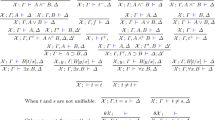Abstract
We empirically investigated the difficulty of finding stable models for logic programs using backtracking, by trying to identify what makes random instances easy or hard. Additionally, we empirically investigated the effectiveness of the 4‐valued Kripke–Kleene semantics (4KK) and the 4‐valued well‐founded semantics (4WF) in the Niemelä and Simons’ backtracking algorithm, smodels, for finding stable models. We studied the behavior of 4KK and 4WF in a parameterized distribution of random propositional logic programs of fixed rule‐length k. In all of our experiments, 4KK and 4WF (both modified to extend an input partial truth assignment) were computed with respect to a fixed percentage of proposition letters (randomly chosen) initially assigned TRUE and a fixed percentage (randomly chosen) initially assigned FALSE. There exists a region, R, in the parameter space of our distribution where smodels required a large number of recursive calls to determine if programs generated in this region have any stable models. Hence, the “hardest” programs for smodels to determine if a stable model exists lie in R. Additionally, there exists a subregion of R where smodels made significantly fewer recursive calls when using 4WF as a pruning technique than when using 4KK. To gain a deeper insight into the causes for the “hardness” of programs in R and the differences between 4WF and 4KK as pruning techniques in smodels, we examined more closely the behavior of 4KK and 4WF. There exists a region in which a very small percentage of inconsistent models were produced by both 4KK and 4WF, thereby providing very little information useful for smodels to immediately backtrack. This region roughly corresponded to the above region where smodels required a large number of recursive calls. Also, there exists a region in which both 4KK and 4WF produced a high percentage of inconsistent models, thereby providing information useful for smodels to immediately backtrack.
Similar content being viewed by others
References
B. Bollobas and A.G. Thomason, Threshold functions, Combinatorica 7 (1987) 35-38.
W. Chen and D. Warren, Computation of stable models and its integration with logical query processing, IEEE Trans. Knowledge Data Engrg. 8(5) (1996) 742-757.
P.M. Dung, On the relations between the stable semantics and the well-founded semantics, Theoret. Comput. Sci. 105 (1992) 7-25.
M. Davis and H. Putnam, A computing procedure for quantification theory, Journal of the ACM 7 (1960) 201-215.
M. Fitting, A Kripke-Kleene semantics for logic programs, J. Logic Programming 4 (1985) 295-312.
M. Fitting, A family of stable models, J. Logic Programming 17 (1993) 197-225.
M. Gelfond and V. Lifschitz, The stable model semantics for logic programming, in: Proceedings of the 5th International Conference Symposium on Logic Programming (1988) pp. 1070-1080.
C. Giannella and J. Schlipf, An empirical study of the 3-valued Kripke-Kleene semantics in random propositional logic programs, in: Proceedings of the 7th International Workshop on Non-Monotonic Reasoning (NM '98) (1998) pp. 41-49.
Knaster, Un théorème sur les fonctions d'ensambles, Ann. Soc. Polon. Math. (1928) 133-134.
T. Larrabee and Y. Tsuji, Evidence for a satisfiability threshold for random 3CNF formulas, Technical Report, University of California, Santa Cruz, CA (1992).
W. Marek, A. Nerode and J. Remmel, How complicated is the set of stable models of a recursive logic program?, Ann. Pure Appl. Logic (1992) 119-135.
W. Marek and M. Truszczynski, Autoepistemic logic, Journal of the ACM (1991) 588-619.
D. Mitchell, B. Selman and H. Levesque, Hard and easy distributions of SAT problems, in: Proceedings of the 10th National Conference on Artificial Intelligence (AAAI-92) (1992) pp. 459-465.
I. Niemelä and P. Simons, Efficient implementation of the well-founded and stable model semantics, in: Proceedings of the 1996 Joint International Conference and Symposium on Logic Programming (1996) pp. 289-303.
P. Simons, Towards constraint satisfaction through logic programs and the stable semantics, Technical Report, Digital Systems Laboratory, Helsinki University of Technology (1997).
V.S. Subrahmanian, D. Nau and C. Vago, WFS + Branch and Bound = stable models, IEEE Trans. Knowledge Data Engrg. (1995) 362-377.
A. Tarski, A lattice-theoretical fixpoint theorem and its applications, Pacific J. Math. 5 (1955) 285-309.
A. Van Gelder, K. Ross and J. Schlipf, The well-founded semantics for general logic programs, Journal of the ACM (1991) 620-650.
A. Van Gelder, The alternating fixpoint of logic programs with Negation, in: Proceedings of the 8th ACM Symposium on Principals of Database Systems (1989) pp. 1-10.
A. Van Gelder, The alternating fixpoint of logic programs with negation, J. Comput. System Sci. (1993) 185-221.
Author information
Authors and Affiliations
Rights and permissions
About this article
Cite this article
Giannella, C., Schlipf, J. An empirical study of the 4‐valued Kripke–Kleene and 4‐valued well‐founded semantics in random propositional logic programs. Annals of Mathematics and Artificial Intelligence 25, 275–309 (1999). https://doi.org/10.1023/A:1018982106545
Issue Date:
DOI: https://doi.org/10.1023/A:1018982106545




